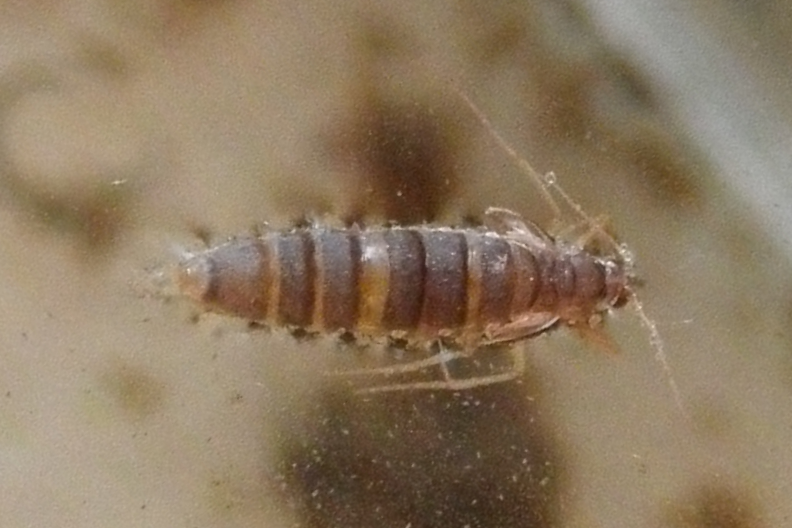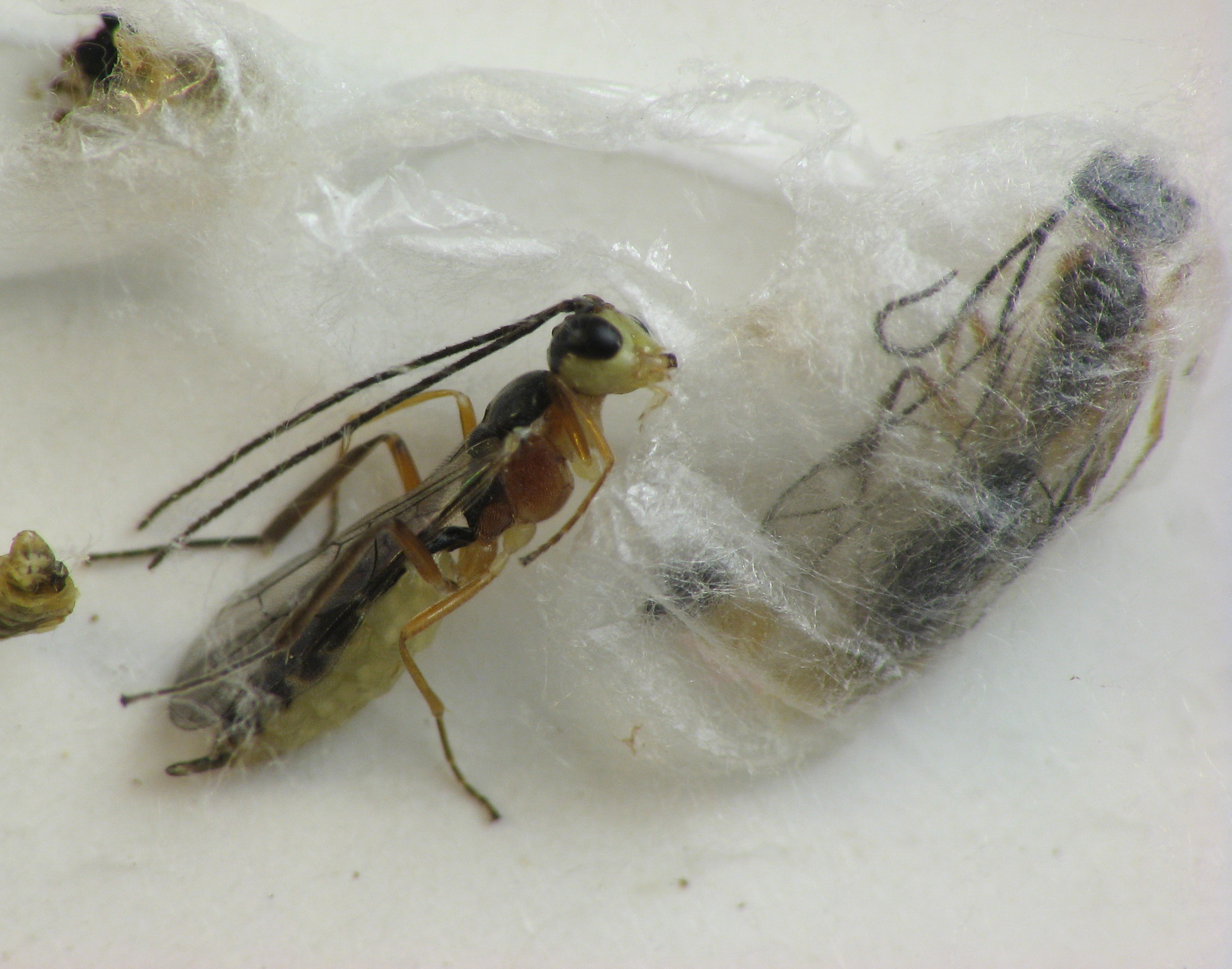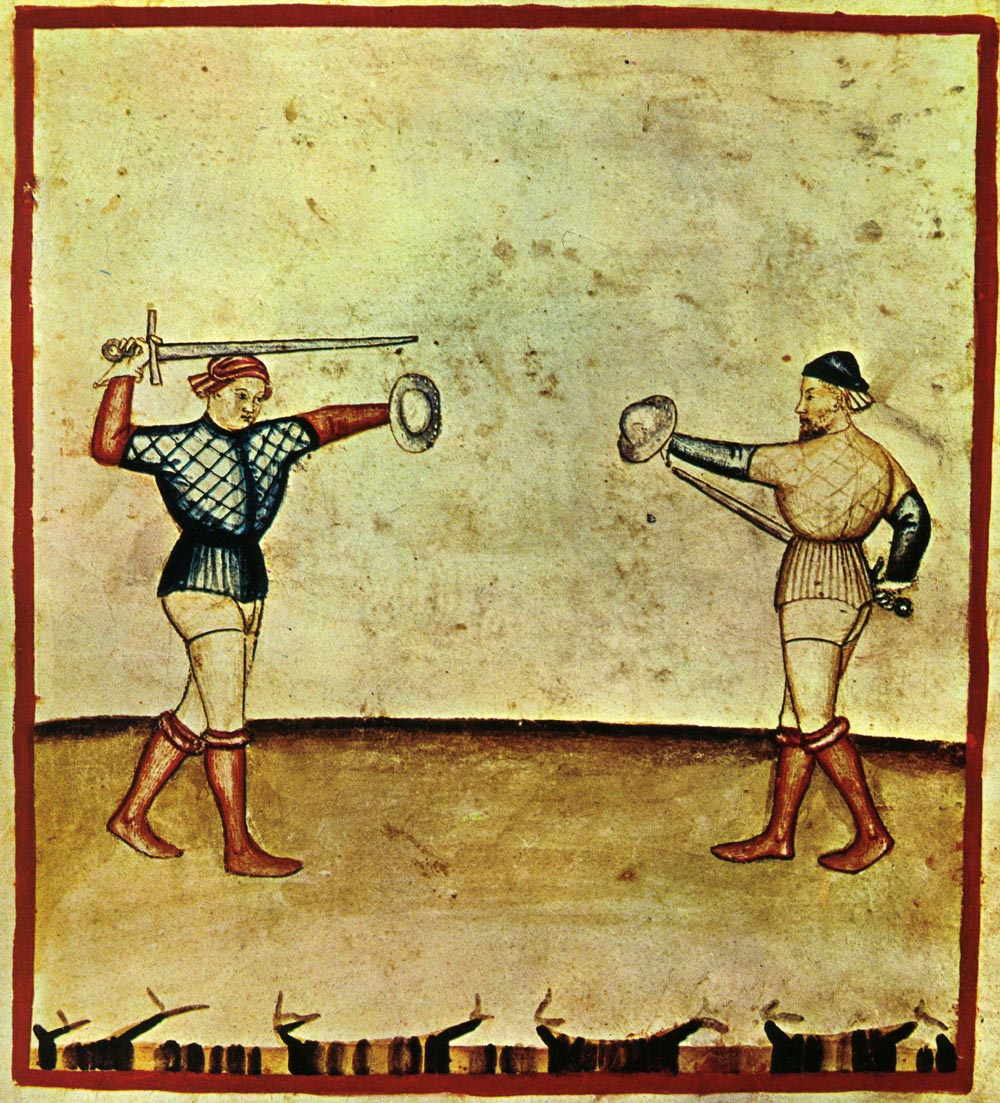|
Acentria Ephemerella
''Acentria'' is a monotypic moth genus of the family Crambidae described by James Francis Stephens in 1829. Its only species, ''Acentria ephemerella'', the watermilfoil moth or water veneer, was described by Michael Denis and Ignaz Schiffermüller in 1775. It is used as an agent of biological pest control against the noxious aquatic plant known as Eurasian watermilfoil (''Myriophyllum spicatum''). The adult male is a white moth with a wingspan of about 12 millimeters. There are two female morphologies. Most females are flightless and live on the surface of the water or just submersed. A few females have longer wings and fly. This is an aquatic insect; most of its life cycle takes place in the water. The female is fertilized at the surface and dives to lay egg masses on aquatic plants, such as watermilfoil. The larva emerges and bores into the stem of the plant, gluing together plant material to create a shelter. It girdles stems as it feeds, which causes significant damage to ... [...More Info...] [...Related Items...] OR: [Wikipedia] [Google] [Baidu] |
James Francis Stephens
James Francis Stephens (16 September 1792 – 22 December 1852) was an English entomologist and naturalist. He is known for his 12 volume ''Illustrations of British Entomology'' (1846) and the ''Manual of British Beetles'' (1839). Early life Stephens was born in Shoreham-by-Sea and studied at Christ's Hospital. His father was a navy captain William James Stephens (d. 1799) and his mother was Mary Peck (later Mrs Dallinger). He went to school at the Blue Coat School, Hertford and later at Christ's Hospital, London. He was then sent to study under Shute Barrington (1734–1826), the bishop of Durham in 1800. He left in 1807 and worked as a clerk in the Admiralty office, Somerset House, from 1807 to 1845 thanks to his uncle Admiral Stephens. Entomology Stephens took an interest in natural history even as a schoolboy. He wrote a manuscript ''Catalogue of British Animals'' in 1808. He was elected fellow of the Linnean Society on 17 February 1815, and of the Zoological Society o ... [...More Info...] [...Related Items...] OR: [Wikipedia] [Google] [Baidu] |
Aquatic Insect
Aquatic insects or water insects live some portion of their life cycle in the water. They feed in the same ways as other insects. Some ''diving'' insects, such as predatory diving beetles, can hunt for food underwater where land-living insects cannot compete. Breathing One problem that aquatic insects must overcome is how to get oxygen while they are under water. Almost all animals require a source of oxygen to live. Insects draw air into their bodies through spiracles, holes found along the sides of the abdomen. These spiracles are connected to tracheal tubes where oxygen can be absorbed. All aquatic insects have become adapted to their environment with the specialization of these structures ;Aquatic adaptations # Simple diffusion over a relatively thin integument # Temporary use of an air bubble # Extraction of oxygen from water using a plastron or blood gill # Storage of oxygen in hemoglobin molecules in hemolymph # Taking oxygen from surface via breathing tubes ( siph ... [...More Info...] [...Related Items...] OR: [Wikipedia] [Google] [Baidu] |
Moths Of North America
Moths are a paraphyletic group of insects that includes all members of the order Lepidoptera that are not butterflies, with moths making up the vast majority of the order. There are thought to be approximately 160,000 species of moth, many of which have yet to be described. Most species of moth are nocturnal, but there are also crepuscular and diurnal species. Differences between butterflies and moths While the butterflies form a monophyletic group, the moths, comprising the rest of the Lepidoptera, do not. Many attempts have been made to group the superfamilies of the Lepidoptera into natural groups, most of which fail because one of the two groups is not monophyletic: Microlepidoptera and Macrolepidoptera, Heterocera and Rhopalocera, Jugatae and Frenatae, Monotrysia and Ditrysia.Scoble, MJ 1995. The Lepidoptera: Form, function and diversity. Oxford, UK: Oxford University Press; 404 p. Although the rules for distinguishing moths from butterflies are not well establishe ... [...More Info...] [...Related Items...] OR: [Wikipedia] [Google] [Baidu] |
Moths Of Europe
Moths are a paraphyletic group of insects that includes all members of the order Lepidoptera that are not butterflies, with moths making up the vast majority of the order. There are thought to be approximately 160,000 species of moth, many of which have yet to be described. Most species of moth are nocturnal, but there are also crepuscular and diurnal species. Differences between butterflies and moths While the butterflies form a monophyletic group, the moths, comprising the rest of the Lepidoptera, do not. Many attempts have been made to group the superfamilies of the Lepidoptera into natural groups, most of which fail because one of the two groups is not monophyletic: Microlepidoptera and Macrolepidoptera, Heterocera and Rhopalocera, Jugatae and Frenatae, Monotrysia and Ditrysia.Scoble, MJ 1995. The Lepidoptera: Form, function and diversity. Oxford, UK: Oxford University Press; 404 p. Although the rules for distinguishing moths from butterflies are not well establis ... [...More Info...] [...Related Items...] OR: [Wikipedia] [Google] [Baidu] |
Biological Pest Control Insects
Biology is the scientific study of life. It is a natural science with a broad scope but has several unifying themes that tie it together as a single, coherent field. For instance, all organisms are made up of cells that process hereditary information encoded in genes, which can be transmitted to future generations. Another major theme is evolution, which explains the unity and diversity of life. Energy processing is also important to life as it allows organisms to move, grow, and reproduce. Finally, all organisms are able to regulate their own internal environments. Biologists are able to study life at multiple levels of organization, from the molecular biology of a cell to the anatomy and physiology of plants and animals, and evolution of populations.Based on definition from: Hence, there are multiple subdisciplines within biology, each defined by the nature of their research questions and the tools that they use. Like other scientists, biologists use the scientific meth ... [...More Info...] [...Related Items...] OR: [Wikipedia] [Google] [Baidu] |
Monotypic Moth Genera
In biology, a monotypic taxon is a taxonomic group (taxon) that contains only one immediately subordinate taxon. A monotypic species is one that does not include subspecies or smaller, infraspecific taxa. In the case of genera, the term "unispecific" or "monospecific" is sometimes preferred. In botanical nomenclature, a monotypic genus is a genus in the special case where a genus and a single species are simultaneously described. In contrast, an oligotypic taxon contains more than one but only a very few subordinate taxa. Examples Just as the term ''monotypic'' is used to describe a taxon including only one subdivision, the contained taxon can also be referred to as monotypic within the higher-level taxon, e.g. a genus monotypic within a family. Some examples of monotypic groups are: Plants * In the order Amborellales, there is only one family, Amborellaceae and there is only one genus, '' Amborella'', and in this genus there is only one species, namely ''Amborella trichopoda.' ... [...More Info...] [...Related Items...] OR: [Wikipedia] [Google] [Baidu] |
Acentropinae
Acentropinae is a fairly small subfamily of the lepidopteran family Crambidae, the crambid snout moths. Species of this subfamily are exclusively found in wetlands and aquatic habitats. Systematics In modern treatments, the former subfamily Nymphulinae is mostly treated as a tribe within Acentropinae. There are about 730 species in 78 genera. Only 13 species in 6 genera are found in Europe. *''Acentria'' Stephens, 1829 (= ''Acentropus'' J. Curtis, 1834; ''Setina'' Hübner, 1819; ''Zancle'' Stephens, 1833) *''Agassiziella'' Yoshiyasu, 1989 (= ''Agassizia'' Yoshiyasu, 1987) *'' Almonia'' Walker, 1866 *'' Anydraula'' Meyrick, 1885 *'' Araeomorpha'' Turner, 1908 (= ''Tholerastis'' Turner, 1915) *''Argyractis'' Hampson, 1897 *''Argyractoides'' Lange, 1956 *''Argyrophorodes'' Marion, 1956 *''Aulacodes'' Guenée, 1854 (= ''Hydrophysa'' Guenée, 1854) *'' Banepa'' Moore, 1888 *''Brevicella'' Kenrick, 1912 *''Callilitha'' Munroe, 1959 *''Cataclysta'' Hübner, 1825 (= ''Catoclysta ... [...More Info...] [...Related Items...] OR: [Wikipedia] [Google] [Baidu] |
Introduced Species
An introduced species, alien species, exotic species, adventive species, immigrant species, foreign species, non-indigenous species, or non-native species is a species living outside its native distributional range, but which has arrived there by human activity, directly or indirectly, and either deliberately or accidentally. Non-native species can have various effects on the local ecosystem. Introduced species that become established and spread beyond the place of introduction are considered naturalized. The process of human-caused introduction is distinguished from biological colonization, in which species spread to new areas through "natural" (non-human) means such as storms and rafting. The Latin expression neobiota captures the characteristic that these species are ''new'' biota to their environment in terms of established biological network (e.g. food web) relationships. Neobiota can further be divided into neozoa (also: neozoons, sing. neozoon, i.e. animals) and neophyt ... [...More Info...] [...Related Items...] OR: [Wikipedia] [Google] [Baidu] |
Pupa
A pupa ( la, pupa, "doll"; plural: ''pupae'') is the life stage of some insects undergoing transformation between immature and mature stages. Insects that go through a pupal stage are holometabolous: they go through four distinct stages in their life cycle, the stages thereof being egg, larva, pupa, and imago. The processes of entering and completing the pupal stage are controlled by the insect's hormones, especially juvenile hormone, prothoracicotropic hormone, and ecdysone. The act of becoming a pupa is called pupation, and the act of emerging from the pupal case is called eclosion or emergence. The pupae of different groups of insects have different names such as ''chrysalis'' for the pupae of butterflies and ''tumbler'' for those of the mosquito family. Pupae may further be enclosed in other structures such as cocoons, nests, or shells. Position in life cycle The pupal stage follows the larval stage and precedes adulthood (''imago'') in insects with complete metamorphosi ... [...More Info...] [...Related Items...] OR: [Wikipedia] [Google] [Baidu] |
Girdling
Girdling, also called ring-barking, is the complete removal of the Bark (botany), bark (consisting of cork cambium or "phellogen", phloem, cambium and sometimes going into the xylem) from around the entire circumference of either a branch or trunk (botany), trunk of a woody plant. Girdling results in the death of the area above the girdle over time. A branch completely girdled will fail and when the main trunk of a tree is girdled, the entire tree will die, if it cannot regrow from above to bridge the wound. Human practices of girdling include forestry, horticulture, and vandalism. Foresters use the practice of girdling to thin forests. Animals such as rodents will girdle trees by feeding on outer bark, often during winter under snow. Girdling can also be caused by herbivorous mammals feeding on plant bark and by birds and insects, both of which can effectively girdle a tree by boring rows of adjacent holes. Orchardists use girdling as a cultural technique to yield larger fr ... [...More Info...] [...Related Items...] OR: [Wikipedia] [Google] [Baidu] |
Larva
A larva (; plural larvae ) is a distinct juvenile form many animals undergo before metamorphosis into adults. Animals with indirect development such as insects, amphibians, or cnidarians typically have a larval phase of their life cycle. The larva's appearance is generally very different from the adult form (''e.g.'' caterpillars and butterflies) including different unique structures and organs that do not occur in the adult form. Their diet may also be considerably different. Larvae are frequently adapted to different environments than adults. For example, some larvae such as tadpoles live almost exclusively in aquatic environments, but can live outside water as adult frogs. By living in a distinct environment, larvae may be given shelter from predators and reduce competition for resources with the adult population. Animals in the larval stage will consume food to fuel their transition into the adult form. In some organisms like polychaetes and barnacles, adults are immobil ... [...More Info...] [...Related Items...] OR: [Wikipedia] [Google] [Baidu] |
Buckler W The Larvæ Of The British Butterflies And Moths PlateCLII
A buckler (French ''bouclier'' 'shield', from Old French ''bocle, boucle'' 'boss') is a small shield, up to 45 cm (up to 18 in) in diameter, gripped in the fist with a central handle behind the boss. While being used in Europe since antiquity, it became more common as a companion weapon in hand-to-hand combat during the Medieval and Renaissance periods. Its size made it poor protection against missile weapons (e.g., arrows) but useful in deflecting the blow of an opponent's weapons, binding his arms, hindering his movements, or punching him. MS I.33, considered the earliest extant armed-combat manual, (around 1300) contains an early description of a system of combat with buckler and sword. Typology According to the typology of Schmidt, there are three main types of buckler regarding their shape: *Type I: round *Type II: rectangular or trapezoid *Type III: oval or teardrop-shaped These types are combined with the cross sections: *Type a: flat *Type b: concave *Type ... [...More Info...] [...Related Items...] OR: [Wikipedia] [Google] [Baidu] |








